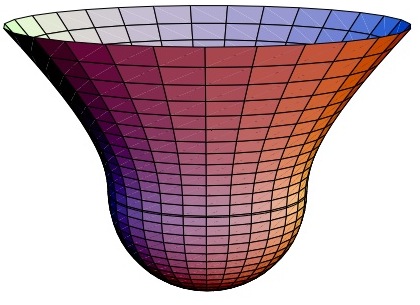The No-Boundary Wave Function of the Universe
The no-boundary wave function (NBWF) is a theory of the quantum state of the universe. Such a state is a necessary part of any final theory along with a theory of quantum dynamics. In principle all predictions depend on both, and predictions of the large scale universe are observationally sensitive to its details.
The discussion of the NBWF is divided into three parts each with a separate set of pages and papers. The present set is concerned with the its formulation. Other sets concern its predictions [nbwfpred] and its simplical approximation [nbwfsimp].
Formulation
The State of the Universe [124]
This paper explains why a theory of the quantum state is a necessary part of any final theory, why ignorance of the state leads to predictions that are inconsistent with observation, and what predictions we expect to depend significantly on the quantum state.
Wave Function of the Universe [55]
(with Stephen Hawking.) This is the original paper where the NBWF was defined for closed cosmologies with simple scalar fields as a sum-over-histories of Euclidean cosmological four-geometries and matter field configurations.
Integration Contours for the No-Boundary Wave Function [88]
(with Jonathan Halliwell.) The sums over geometries defining the NBWF cannot be simply over real Euclidean configurations. The sum would diverge and classical spacetime would not be predicted. The contour of integration must therefore be partially complex, and, in particular, involve a complex rotation of conformal degrees of freedom (a conformal rotation). The definition of the NBWF requires a choice of contour. This paper discussed the possibilities for that contour and the constraints on its choice.
Wave Functions Constructed from Invariant Sums-Over-Histories Satisfy Constraints [89]
(with Jonathan Halliwell.) Wave functions specifying a quantum state of the universe must necessarily satisfy the constraints of general relativity arising from its diffeomorphism invariance. In particular they must satisfy the Hamiltonian constraint whose operator form is called the Wheeler-DeWitt equation. This paper shows for a wide class of theories how wave functions constructed from sums-over-histories formally satisfy operator forms of the constraints provided the sum-over-histories respects the symmetries that implied the constraints. The NBWF is a particular example.
Simplicial Formulation [simpmss]
The sums-over-geometries that define the NBWF can be modeled by sums over piecewise linear geometries specified by a finite number of edge lengths of simplices rather like a geodesic dome in two dimensions. There are a set of separate pages with papers developing simplicial approximation [simpmss].
Ground State Wave Functional of Linearized Gravity [61]
This paper shows explicitly that when the Euclidean sum-over-histories constructions of the NBWF is applied to linearized gravity the result is the ground state wave function for a free spin-2 field theory --- as expected.
Conformal Rotation in Linearized Gravity [69]
(with Kristin Schleich.) This paper shows how the conformal rotation can be derived in linearized gravity from the Hamiltonian formulation of a free spin-two field theory. The derivation starts from the ground state wave function expressed as a sum over the histories of the true physical degrees of freedom involving a non-local action. This is transformed into a a sum-over-histories involving the local action of general relativity with a conformal factor rotated to complex directions.
Holographic No-Boundary Measure [148]
(with Thomas Hertog.) This paper shows how the leading order semiclassical approximation to the NBWF is given in terms of the partition function of field theories on the final boundary that contain deformations of the kind occurring in AdS/CFT dualities. If this connection holds beyond the leading order approximation it would provide a formulation of the NBWF that does not involve Euclidean sums over geometries and thus extend its scope.
